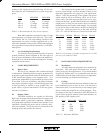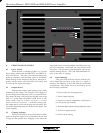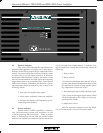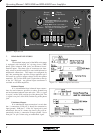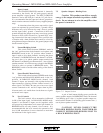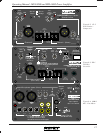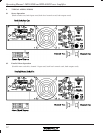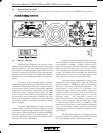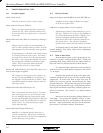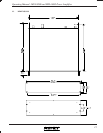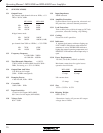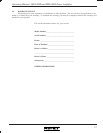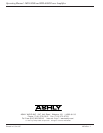
Operating Manual - MFA-8000 and MFA-6000 Power Amplifier
14
11. TROUBLESHOOTING TIPS
11.1 No Audio Output
Power switch not lit:
Line fuse is blown or power outlet is dead.
Power switch is lit but no LEDs lit:
There is no input signal applied or input level
controls are off. Note: In parallel mono mode,
be sure that only one signal source is connected
to the amp.
Protect LED and Limit LEDs are lit and relay clicking is
heard:
Output is short circuited or load impedance is
too low. Check speaker cables for shorts, increase
load impedance by disconnecting some speakers.
A high frequency oscillation in the sound system
is occurring when the relays close. Turn down
the input level controls to verify that the ampli-
fier alone is not causing the problem. Be sure to
use good quality shielded and balanced input
cables. Do not run input cables alongside
output speaker wires over long lengths.
Protect and Limit LEDs are lit, Clip LED comes on as
soon as input signal is applied:
DC voltage may be present on the output or an
internal 15 amp type MDA slow acting fuse on
the amplifier circuit board may be blown. Have
a qualified technician replace the fuse with the
same type of fuse.
Protect LED and Limit LED only are lit:
This is the normal status for the first 2 seconds
after switching power on. If this status contin-
ues, the amplifier may be protecting the speak
ers from an abnormally high frequency and high
amplitude signal. The problem may be with the
signal source. Try disconnecting the signal
source from the amp.
Protect LED and Thermal LED are lit:
Amplifier is in thermal protect mode due to
extreme overheating. Allow better ventilation,
reduce signal levels or increase load impedance
by disconnecting some speakers.
11.2 Distorted Sound
Output level meters indicate 0dB level (red CLIP LED on):
Amplifier is being clipped. Reduce the signal
level at the signal source.
0 dB level on output meters is never reached:
Applied input signal is distorted before it gets to
the amp. Check to see if a piece of equipment in
the signal chain before the amp is clipping. Nor-
mally the amplifier should be operated with
input levels fully CW to maximize headroom in
the signal source. Also check for damaged
speaker drivers that could cause distorted sound.
If distorted sound is still heard, there may be an
internal problem. Call Ashly Audio service department
at 800-828-6308.
11.3 Hum or Buzz Noise
Be sure that the power cord’s 3-prong plug is con-
nected to a properly earth-grounded outlet. Lifting the
grounding third prong usually does not improve hum or
buzz and creates a potential electrical shock hazard.
Use balanced input connections with a balanced
audio source for best hum and buzz rejection. See section
7.1 on inputs.
Normally the ground lift strap on the input screw
terminals should be left in place for best ground voltage
suppression. In some cases hum or buzz noise may be
induced by excessive ground current through the input
ground connection. This current path may be interrupted
by removing the ground lift strap. If the problem persists,
input signal transformers providing complete ground iso-
lation are available. See section 8.1 on Input Isolation
Transformer.
Buzz noise can be caused by lighting dimmers or
neon lights. Try moving the amplifier, wiring, or light-
ing to different locations to see if lighting is the source of
the buzz. Input transformers may also fix the problem.
See section 8.1 on Input Isolation Transformer.



